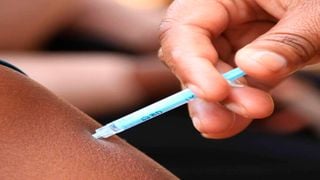
A health worker administers Covid-19 vaccine on September 20, 2021.
| Joseph Kanyi | Nation Media GroupNews
Premium
Experts warn of deadly fifth Covid-19 wave
What you need to know:
- The highest peak of deaths in Kenya was in the third wave when the country lost about 40 Kenyans per day.
- The modelling estimates that during the fifth wave, the country will record close to 75,000 infections.
Experts are predicting that Kenya will hit the peak of the fifth wave in November, and if proper measures are not taken, it will result in the death of 3,000 people.
According to the projection, if the peak is mild, then close to 1,000 people will succumb to the virus. The highest peak of deaths in Kenya was in the third wave when the country lost about 40 Kenyans per day.
The modelling done by Dr Shem Sam Otoi, who is the Covid-19 programmes coordinator for the Lake Region Economic Block (LREB), estimates that during the fifth wave, the country will record close to 75,000 infections with about 50,000 people developing mild symptoms.
Dr Otoi told the Saturday Nation that if more people get vaccinated with no variants of concern in the population, then the peak is likely to be mild.
“The determinant of the fifth wave lies in the vaccination uptake in the country, if 51 per cent of Kenyans are vaccinated, even if we have waves, they will be very low and we will even fail to notice them. Vaccination reduces the intensity of waves,” he said.
Explaining why we are likely to experience a peak in November, Dr Otoi said that from their calculations, the average period between waves is 54 to 60 days.
More severe peaks
“From our calculations, the fifth wave will decline in January next year and the sixth wave is likely to run from March next year,” he said.
He added: “With full vaccination, we will have reduced the severity of possible attacks and attack rates. We just have to go for vaccination if we want to remain safe.”
Dr Otoi said that parts of the country with high population and low vaccine uptake are likely to experience more severe peaks than others.
His sentiments were earlier echoed by National Covid-19 vaccine deployment task force chairman Willis Akhwale who said there was vaccine apathy in the LREB region.
“These are the same counties that were hard hit by the spike in the third wave and we expect them to be in the forefront in taking the vaccine. If the trend continues like this, then I am afraid they are the same people who will be hit hard by the consequent waves because the regions are densely populated,” Dr Akhwale said.
“We expected densely populated counties including Kakamega, Bungoma,Vihiga and Homa Bay to lead in the number of people who are fully vaccinated, unfortunately, they are doing very poorly,” Dr Akhwale added. “We are not going to win this war if we are taking our time to get vaccinated yet the vaccines are available. In case we get another wave, those who are likely to survive are those who have been vaccinated,” he said.
Low uptake of vaccines
In the LREB region, there are 8,003,755 adults eligible for vaccination. Of these, only 170,235 have been fully vaccinated, accounting for 2.1 per cent.
From the modelling, unvaccinated adults are 1.3 per cent times more likely to succumb to Covid-19, with a 127 per cent likelihood.
The model also shows that people aged 50 and above are 47 per cent more likely to succumb to Covid-19 without being vaccinated.
“The exponential growth of mortality risk by age calls for protection of the elderly by vaccination. Vaccination is the most effective defense in the evolution of covid-19 given the multiplicity of different variants,” said Dr Otoi.
Also, from the modelling, a patient in Kenya is 27 percent more likely to succumb to Covid-19 because of insufficient oxygen flow in county health facilities.
Pointing out the gaps, the model shows that the low uptake of vaccines in the elderly population is coupled with little to no digital literacy, which has resulted in low online registration for vaccination.





